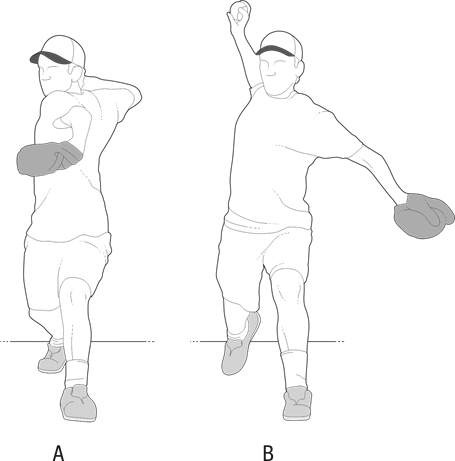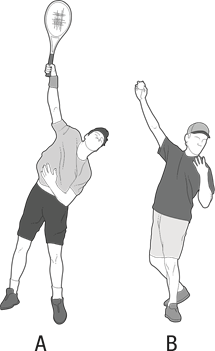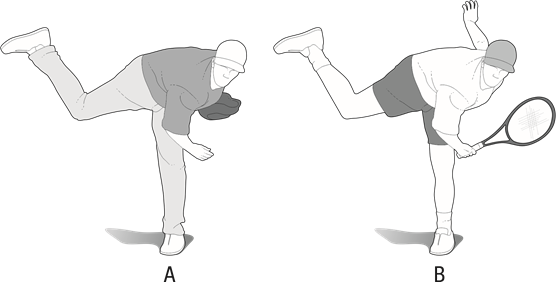MOJ
eISSN: 2574-9935


Short Communication Volume 6 Issue 3
Motor Sciences Ministry of Education, Italy
Correspondence: Rodolfo Lisi, Motor Sciences Ministry of Education, IIS A Meucci- Ronciglione (VT), Italy
Received: August 20, 2023 | Published: September 1, 2023
Citation: Lisi R. Tennis serves versus baseball pitch: similarities and differences. MOJ Sports Med. 2023;6(3):93-95. DOI: 10.15406/mojsm.2023.06.00147
Typical gestures of tennis and baseball, as well as of all the so-called "overhead" sports (those activities, that is, which involve raising the arm above the head), have some kinematic aspects in common, but different kinetics. In other words, the movement of the upper limb is quite similar, but the forces involved and the musculoskeletal stresses differ significantly with implications that can affect the whole body.
Keywords: tennis serves, baseball pitch, kinetic chain, elbow, injuries
A fundamental characteristic that tennis and baseball have in common is the use of the ball, to which energy is transmitted through direct contact with the hand (in baseball, the action of the pitcher or "thrower") or, giving rise to a collision, through the “use of tools” (in tennis, the player executes the stroke, or the shot, using the racket).1 The movements we are talking about, essentially, can be included in the translocation movements, where the direct or indirect movement of the tools causes mechanical stresses the motor systems of the athlete. In tennis, the impact changes the momentum of the ball through an exchange of energy with the racket. In baseball, the bound state of the ball changes from being one with the hand to a free body moving with a momentum equal to the product of the velocity of release times its mass.2
The launch phase consists of the movement necessary to bring the racket or arm into the desired position for impact or release, with optimal orientation and speed for the intended goal. This phase which tends to minimize the moments of inertia in order to obtain high angular accelerations implies the adoption of various motor strategies aimed at giving the ball kinematics and dynamics functional to the type of hit or throw desired.
In baseball, pitcher starts from the "mound" (aka the hill), a small bump raised 0.25 m. At the moment of the release of the ball, the player's center of mass is one level lower than the starting position. The greater the difference in height or vertical difference, the greater the change in potential energy of the center of mass will be. Obviously, since the mechanical energy of a free-falling body is conserved, the difference in kinetic energy will be equal to the change in potential energy.2
The above is valid from a strictly mechanical point of view. However, we cannot forget that the speed addendum we are talking about is directed downwards; it follows that the athlete - to guarantee the correctness of the throw - will have to act by introducing corrections (with respect to the movement on the flat) which can cause greater stresses in terms of mechanical moments of torsion of the arm on the body and of the entire trunk on the lower limbs in the phase of "braking" or closure of the gesture. If only the horizontal and vertical components of the velocity vector of the center of mass are considered (two-dimensional analysis), the horizontal velocity of the tennis player is lower than that of the pitcher. These, starting from a bump raised with respect to the court ("stride/cocking" phase), execute the action with a large run-up step (horizontal translocation) while tennis player, also due to the regulation (the serve must be made by the player, stationary, beyond the baseline of the field), moves essentially vertically. Compared to the tennis player, therefore, the horizontal space covered by the center of mass of the pitcher's body is much greater.2
The correct execution of tennis serve requires the use of the synergistic interaction of the various osteoarthromuscular constituents (kinetic chain) involved in the action. After assuming the position to serve, tennis player carries out the immersion movement, i.e. the entire loading phase of the game start shot (Figure 1). This phase consists first of all in rotating the trunk around the longitudinal axis in the direction of the racket arm (Figure 1A), and finally in flexing the legs simultaneously with the ball thrown with the non-dominant hand: the player will thus come to be in the so-called loading position or, also, "trophy" (Figure 1B).2 In this way, the trunk and lower extremities coordinate with the shoulder internal rotators, storing elastic energy through an initial eccentric stretch. The accumulated elastic energy will then be released in the subsequent phase of concentric acceleration in shortening.3 It is therefore necessary that the rotational movement of the trunk is perfectly integrated with the other elements of the kinetic chain both in terms of timing and intensity, so that the mechanism of reusing elastic energy can be fully exploited.
In baseball the main difference, at the various levels of competition, is represented by the timing of the rotation of the trunk with respect to the pelvis (Figure 2). During “throwing phase”, the action of the arms must be well balanced to obtain the maximum advantage on the rotation of the trunk, also allowing the pre-stretching of some muscle groups, such as, for example, the pectoralis major (as well as occurs in throwing the javelin). At this stage (maximum pre-stretch) both elbows should be at shoulder level. This will allow for a correct position of the humerus in the shoulder capsule.

Figure 2 The correctly performed loading phase sees the humerus aligned with the scapular plane (A). Otherwise a mechanism called hyperangulation" (B),5 is created according to which an increase in the horizontal abduction amplitude of the shoulder during the loading phase of the arm ("cock position") is correlated to a greater predisposition to the onset of pathologies at the level of the anatomical districts mentioned several times.5
Professional pitchers have delayed trunk rotation (Figure 2A) compared to less experienced pitchers (Figure 2B). Rotating the trunk before the humerus and scapula are properly positioned leads to excessive horizontal abduction of the upper limb.4
The so-called "leading with the elbow" (the Italian colloquial term closest to the English expression is "lanciare col gomito" or "guidare il lancio col gomito"), a connecting element between the loading and acceleration phases, embraces different opinions. This modality (Figure 3), consisting of an exaggerated increase in horizontal adduction of the shoulder and in elbow flexion, divides the experts: some, more interested in measuring performance and, therefore, in achieving high output speeds of the ball, question the real effectiveness of the prevalence of the elbow over the other joints in the dynamics of the throw; others, more oriented towards health and accident prevention, recall how the adoption of the "leading with the elbow" exposes the elbow to violent valgus stress transmitted mainly on the anterior bundle of the ulnar collateral ligament. The same considerations and concerns also apply to tennis. The characteristic "whirlpool", also known as a "loop", is the semicircular or ring movement that the racket generates behind the back. The execution of this gesture is aimed at achieving maximum speed and precision on impact. While the head of the racket descends behind the shoulders thanks to the flexion of the forearm on the arm (the contraction of the triceps brachii will allow the frame to be given high speeds), the torso and shoulders rotate forward thus creating a dragging action. The characteristic "whip", which is achieved precisely with the advance of the elbow (Figure 4) and, subsequently, through the intervention of the forearm and hand, consists in a rapid acceleration of the "arm-racquet" necessary for the transfer of the elastic energy accumulated in the loading phase.2
Representation of an extreme case: the thrower, at the end of the load, has his hand near the nape of his neck and his elbow pointing in the direction of the target in front of his chest. In this position, the pitcher relies almost exclusively on elbow extension rather than shoulder internal rotation.
The "body-racket" energy transfer goes through the elbow. The segmental and joint attitude, at the end of the loading, has a strong influence on the effectiveness of the blow and, at the same time, on the muscleosteotendon stresses.
In case of tennis, the impact of the racket on the ball is certainly the most important phase of the shot. In the final phase of throwing, compared to the pitcher, the moment of inertia of the entire upper limb of the tennis player is higher precisely because of the additional mass of the implement. With r being equal, greater mass means greater inertia: that is, it will be necessary to use a more intense force to overcome the reluctance to move. In both gestures, the impact with the ball or its release takes place with the dominant arm in a "long" position. Specifically, however, the center of mass of the "arm-racket" system is further away from the axis of rotation (shoulder) due to the length of the racket itself. Hence r tennis player > r pitcher. In extreme summary, the tennis player's arm is more reluctant to move than the pitcher's, requiring greater muscle intervention to obtain the same rotational angular velocity.2
Priest, Jones & Nagel recall how tennis serve (Figure 5A) is considered a variant of "overhand throwing" (Figure 5B), the best known of the four "throwing styles" of baseball.5 The opening stroke, however, differs in two respects: nothing is released at the end of the intense "overhand" movement while there is a collision at the top of the "swing". A tennis player's elbow, therefore, is exposed not only to medial stress as in a baseball pitcher but also to the additional stress from hitting the racket with the ball (Figure 5).6

Figure 5 A. Tennis serve; B. The overhand swing, one of the four "slots" used by a baseball pitcher.
Tennis serve is characterized, during the delicate "follow through" phase, by an abrupt and energetic deceleration of the arm-racket system after the impact with the ball (Figure 6B). Overall, this is a movement broken up into its sub-phases, inhibited in its fluidity: the impact disturbs the motion of the racket for a very brief instant, generating a solicitation that is transmitted to the entire upper limb. The trajectory of the racket, after the hit, continues its path until it closes towards the side opposite the dominant limb (Figure 6A). In baseball pitching, on the other hand, the closing phase following the release of the ball by the pitcher is the natural load of the upper limb which, unlike in tennis, does not hold any tool (Figure 6).2

Figure 6 In tennis (B), concentric contraction of the internal rotators of the shoulder (“impulse phase” on the ball) is slowed by an eccentric contraction of the external rotators of the shoulder joint (infraspinatus and teres minor) during the subsequent “follow through” phase.7 The external rotators are used to "slow down" ("brake") the momentum of the racquet arm in rapid internal rotation. The same thing applies in baseball (A), except for one detail: the pitcher's hand does not hold a racket and, therefore, the hand-wrist area (and, consequently, the forearm muscles) is less stressed.
Given the above, however, the cinematic sequences between tennis serve and baseball pitch are very similar but not the same. Observing the two gestures, there are a series of mechanical differences and, probably, precisely these differences explain the discrepancy of the harmful effects on the Osteoarticular apparatus of the athletes.2
None.
The author declares that there are no conflicts of interest.

©2023 Lisi. This is an open access article distributed under the terms of the, which permits unrestricted use, distribution, and build upon your work non-commercially.